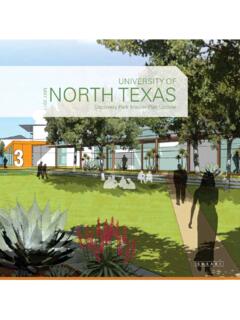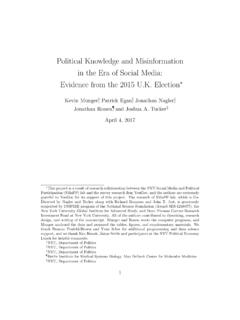Transcription of Misinformation about the misinformation effect.
1 APPROVED: Jes s Rosales-Ruiz, Major Professor Jonathan Pinkston, Committee Member Shahla Ala'i-Rosales, Committee Member Thomas Evenson, Dean of the College of Public Affairs and Community Service Mark Wardell, Dean of the Toulouse Graduate School Misinformation about THE Misinformation EFFECT Lars I. Halvorsen Thesis Prepared for the Degree of MASTER OF SCIENCE UNIVERSITY OF NORTH TEXAS August 2012 Halvorsen, Lars I. Misinformation about the Misinformation effect. Master of Science (Behavior Analysis), Aug 2012, 41 pp., 1 table, 6 figures, references, 33 titles. This study partially replicated the research of Cook, Kwak, Hoffman, & Loftus where they examined post-event activities that induces subjects to pick a wrong person in a forced choice identification procedure.
2 The goal was to investigate if providing a neither option to a match to sample task increases the accuracy of responding. Subjects were asked to study three faces for 10 seconds, after which they were asked to pick out the faces in a forced choice setting where two other faces were presented. Later the subjects were asked to pick out faces in a setting in which they could use a neither option. Results indicated that a generalization effect occurs when identifying faces and the effect is seen as subjects choosing the wrong face. This suggests that when using faces with some similar features in a lineup setting the procedure may cause the subject to pick the wrong person. ii Copyright 2012 by Lars I. Halvorsen iii ACKNOWLEDGEMENTS First I would like to thank my advisor Jes s Rosales-Ruiz whose help has been instrumental in writing this thesis, your dedication to the students goes beyond what I could have imagined as does your passion for the field.
3 I would like to thank Jonathan Pinkston and Shahla Ala'i-Rosales that has been very patient and given me some amazing insights. I would like to thank my cohort for listening to my thoughts and coming with ideas and suggestions as to what I could do. And last but not least my family that has supported me throughout my studies. iv TABLE OF CONTENTS ACKNOWLEDGEMENTS .. III LIST OF TABLES AND V INTRODUCTION .. 1 METHODS .. 5 Subjects .. 5 Setting .. 5 Materials .. 5 PROCEDURE .. 6 Procedures for All Groups .. 6 Forced Choice Condition .. 6 Study Phase .. 6 Quiz Phase .. 7 Test 1 .. 7 Test 2 .. 7 Neither 8 DESIGN .. 9 RESULTS .. 11 Forced Choice Condition First (Picture Set 1) .. 11 Neither Choice Condition First (Picture Set 2) .. 13 DISCUSSION.
4 15 CONCLUSION .. 22 APPENDIX A INFORMED 29 APPENDIX B DATA GATHERING SHEET .. 32 APPENDIX C PICTURES USED AND THE ORDER OF PRESENTATION .. 35 REFERENCES .. 39 v LIST OF TABLES AND FIGURES Page Tables Table 1 Manipulations Made in the Experiment, Picture Set 1 .. 9 Table 2 Manipulations Made in the Experiment, Picture Set 2 .. 10 Table C1. Manipulations Made in the Experiment (Both Sets) ..38 Figures Figure 1. Forced choice condition first and neither condition second.. 23 Figure 2. Forced choice condition first and neither condition second.. 24 Figure 3. Forced choice condition first and neither condition second.. 25 Figure 4. Neither condition first and forced choice condition second.. 26 Figure 5. Neither condition first and forced choice condition second.
5 27 Figure 6. Neither condition first and forced choice condition second.. 28 1 INTRODUCTION Eyewitness accounts are used in many situations to establish facts about environmental stimuli. Our court systems convict individuals for crimes using eyewitness accounts. Insurance companies regularly rely on eyewitness a ccounts for information about accidents and police investigations are often directed by eyewitness accounts. However, the reliability of eyewitness accounts has been called into question and been made the subjects of many research studies. Nonetheless eyewitness testimony is frequently used to establish identification, perhaps because a better tool has not yet been developed. The Innocence Project has reported Over 230 people serving an average of 12 years in prison have been exonerated through DNA testing in the United States and 75% of those wrongful convictions (179 individual cases) involved eyewitness misidentification.
6 In half of the misidentification cases the eyewitness testimony was the central evidence used against the defendant (Grisham, 2009, p 3). The Innocence Project is a national litigation and public policy organization dedicated to exonerating wrongfully convicted individuals through DNA testing and reforming the criminal justice system to prevent future injustice (Grisham, 2011). In a lineup setting there are many factors that influence the responses of the eyewitness. Wells and Loftus (2003) mention some factors that may influence accuracy of identification such as the way a question is worded, the degree of similarity among the people in the lineup, the initial description and whether the witness has seen pictures of the alleged criminal. In recent years many efforts have been made to decrease the influence of variables such as a reduction of unscripted 2 conversation during the procedure and the standardization of the presentation of pictures.
7 Even with the recent procedural improvements, accuracy of performance on the lineup task is still not sufficient. Cook, Kwak, Hoffman and Loftus (2009) conducted an experiment where they investigated if postevent activities would affect a subject s ability to accurately identify the right person in a lineup setting. Their study was done in three phases: a study phase, a quiz phase and a test phase. During the study phase, three pictures of faces were presented individually, projected on a screen in front of the subjects. During the quiz phase the subjects had to identify the picture of the faces from two comparisons; subjects were asked to indicate the correct picture by writing L (left) or R (right) on a piece of paper. The first set of comparisons contained one picture that was shown in the study face and one that had not been shown in the study phase.
8 The second set of comparisons contained one face that resembled the picture shown in the study phase and one that had not been shown in the study phase. The third set of comparisons contained a picture that had been shown in the study phase and a picture shown in the quiz phase. Subjects often picked one of the faces shown in the quiz phase. Cook et al. (2009) did misinform their subjects during their experiment. Cook et al. (2009) concluded that: Postevent activity that induces subjects to pick a wrong person affects later ability to accurately identify the right person. Committing to the postevent information produces larger effect, but mere exposure without choosing also impairs final memory performance. (p. 26) The phenomenon is known as the Misinformation effect and has been extensively investigated by several studies (Lindsay, Allen, Chan & Dahl, 2004; Loftus, 1975; Loftus & Palmer, 1974; Marche, Brainred, & Reyna, 2010; Mitchell & 3 Zaragoza, 1996; Wright & Loftus, 1998).
9 The Misinformation effect refers to instances in which memory for an event changes as a result of post-event information. Explanations for the effect appeal to inferred processes such as selective memory, selective failure to remember, false memories for things not actually witnessed or experienced, and hindsight biases that all can be factors in creating a Misinformation effect ( Zhu, Chen, Loftus, Lin, He, Chen, Li and Moyzis, 2010; Davis and Loftus, 2007; Cook, Kwak, Hoffman and Loftus (2009)). Lindsay, 1990; Lindsay, Allen 2004; Mitchell & Johnson, 2000 investigated source monitoring, that is information integrated through sematic memory and Challies, Hunt, Garry and Harper, (2011) suggests that the Misinformation effect is equivalence relations. The purpose of this study was to investigate the effects of a neither response option on the accuracy of a face identification task used to study the Misinformation effect.
10 Most research, if not all, has been done using forced choice matching procedures. Rosales-Ruiz, Pasley and Potucek (1992) tested delayed matching-to-sample (MTS). They investigated competing control by certain comparison stimuli or positions. The study examined an identity sorting task that had some features in common with the standard MTS procedure. They used three boxes in a discrimination sorting task where one box was used as different . Comparing the task with a sorting task where there was no option to sort as different . Rosales-Ruiz, Pasley and Potucek (1992) found that stimulus control inferred from forced choice matching tasks does not hold in tasks where there is a response option that indicates that the stimuli does not match the sample. Thus, there is a possibility that the Misinformation effect is not produced by postevent activities directly experienced by the witness before identification or indirectly through semantic memory or equivalence relations, 4 rather the effect is directly produced by forcing subjects to choose among stimuli during the identification task.



















